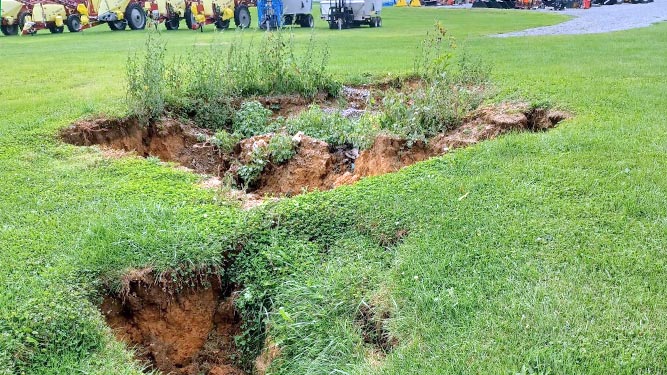Every year, sinkholes cause significant damage to personal property and public infrastructure in Pennsylvania.
Knowing your local geology can help you find out if you could be impacted so you can be prepared.
The Department of Conservation and Natural Resources Bureau of Geological Survey can help with information.
What Causes Sinkholes

Sinkhole in Centre County. Photo: Charlie Miller.
Carbonate rocks, such as limestone, can weather slowly through dissolution.
This is when water comes into contact with rocks, usually through fractures in the rock, and dissolves the minerals that make them up.
This weathering process results in enlarged underground fractures and cavities.
These voids can be completely clogged by clay, sand, and gravel and have no surface expression.
Sinkholes form when the land surface collapses after those deeper, supporting sediments wash into empty areas underground.
A sinkhole can be triggered by natural means like major rainfall events or by failure of infrastructure like a water main break.
They often appear circular from above and funnel-shaped in side-view.
Changing Climate Could Mean More Sinkholes
Climate change forecasts predict more frequent and intense storms.
Many clogged sinkholes are currently in balance with the water that falls on the surface -- the same way a slow draining bathroom sink may not be a problem if you only turn the water on low.
The more water added to the system can overwhelm the balance and flush open the natural filling, just like running a pressure washer on high removes more material.
Once the hole is open, water rushing in can cause it to grow.

Sinkhole in Lebanon County.
Climate change also predicts more droughts. The groundwater table may lower significantly during a drought.
The water table provides support of the land surface, and when lowered and raised repeatedly it can flush open the sediment that had been filling the voids the same way the push-pull of a toilet plunger can move a clog.
These events can contribute to sinkholes forming in areas with limestone, dolostone, or marble bedrock.
Steps to Prevent Sinkholes at Home
PaGEODE is an interactive map of Pennsylvania's geology and natural resources.
Enter your address to find your property and click the map to identify the geology at that spot. Look on the left for the types of rock present -- look for limestone, dolomite, and marble.
The interactive map layers also can be used to find reported sinkholes in your area.
To protect your home or property, manage the flow of water during storms.
Extend the downspouts on homes and buildings which will push the potential hazard away from infrastructure.
During rainy weather, observe where water ponds as this could indicate a potential hazard area. Visually inspect stormwater basins after storms for any new openings.
Never drive through flooded roads, it is impossible to tell the depth and speed of the water and erosion may have removed the road surface and the sinkhole will not be visible.
If you see a sinkhole in a roadway, report it to either the Pennsylvania Department of Transportation or municipal road authorities.
If a sinkhole opens on your property, contact the Pennsylvania Geological Survey at 717-702-2017 to help determine the cause of the collapse and suggest ways to repair it.